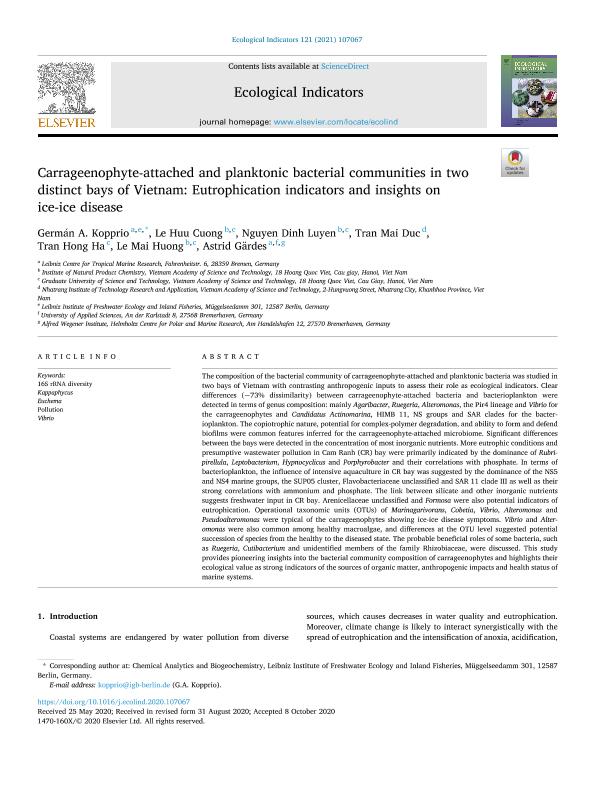Mostrar el registro sencillo del ítem
dc.contributor.author
Kopprio, Germán Adolfo

dc.contributor.author
Cuong, Le Huu
dc.contributor.author
Luyen, Nguyen Dinh
dc.contributor.author
Duc, Tran Mai
dc.contributor.author
Ha, Tran Hong
dc.contributor.author
Huong, Le Mai
dc.contributor.author
Gärdes, Astrid
dc.date.available
2021-07-28T15:37:39Z
dc.date.issued
2021-02-23
dc.identifier.citation
Kopprio, Germán Adolfo; Cuong, Le Huu; Luyen, Nguyen Dinh; Duc, Tran Mai; Ha, Tran Hong; et al.; Carrageenophyte-attached and planktonic bacterial communities in two distinct bays of Vietnam: Eutrophication indicators and insights on ice-ice disease; Elsevier Science; Ecological Indicators; 121; 23-2-2021; 1 - 11
dc.identifier.issn
1470-160X
dc.identifier.uri
http://hdl.handle.net/11336/137206
dc.description.abstract
The composition of the bacterial community of carrageenophyte-attached and planktonic bacteria was studied in two bays of Vietnam with contrasting anthropogenic inputs to assess their role as ecological indicators. Clear differences (~73% dissimilarity) between carrageenophyte-attached bacteria and bacterioplankton were detected in terms of genus composition: mainly Agaribacter, Ruegeria, Alteromonas, the Pir4 lineage and Vibrio for the carrageenophytes and Candidatus Actinomarina, HIMB 11, NS groups and SAR clades for the bacterioplankton. The copiotrophic nature, potential for complex-polymer degradation, and ability to form and defend biofilms were common features inferred for the carrageenophyte-attached microbiome. Significant differences between the bays were detected in the concentration of most inorganic nutrients. More eutrophic conditions and presumptive wastewater pollution in Cam Ranh (CR) bay were primarily indicated by the dominance of Rubripirellula, Leptobacterium, Hypnocyclicus and Porphyrobacter and their correlations with phosphate. In terms of bacterioplankton, the influence of intensive aquaculture in CR bay was suggested by the dominance of the NS5 and NS4 marine groups, the SUP05 cluster, Flavobacteriaceae unclassified and SAR 11 clade III as well as their strong correlations with ammonium and phosphate. The link between silicate and other inorganic nutrients suggests freshwater input in CR bay. Arenicellaceae unclassified and Formosa were also potential indicators of eutrophication. Operational taxonomic units (OTUs) of Marinagarivorans, Cobetia, Vibrio, Alteromonas and Pseudoalteromonas were typical of the carrageenophytes showing ice-ice disease symptoms. Vibrio and Alteromonas were also common among healthy macroalgae, and differences at the OTU level suggested potential succession of species from the healthy to the diseased state. The probable beneficial roles of some bacteria, such as Ruegeria, Cutibacterium and unidentified members of the family Rhizobiaceae, were discussed. This study provides pioneering insights into the bacterial community composition of carrageenophytes and highlights their ecological value as strong indicators of the sources of organic matter, anthropogenic impacts and health status of marine systems.
dc.format
application/pdf
dc.language.iso
eng
dc.publisher
Elsevier Science

dc.rights
info:eu-repo/semantics/openAccess
dc.rights.uri
https://creativecommons.org/licenses/by-nc-nd/2.5/ar/
dc.subject
16S RRNA DIVERSITY
dc.subject
EUCHEMA
dc.subject
KAPPAPHYCUS
dc.subject
POLLUTION
dc.subject
VIBRIO
dc.subject.classification
Oceanografía, Hidrología, Recursos Hídricos

dc.subject.classification
Ciencias de la Tierra y relacionadas con el Medio Ambiente

dc.subject.classification
CIENCIAS NATURALES Y EXACTAS

dc.subject.classification
Biología Celular, Microbiología

dc.subject.classification
Ciencias Biológicas

dc.subject.classification
CIENCIAS NATURALES Y EXACTAS

dc.subject.classification
Ciencias Medioambientales

dc.subject.classification
Ciencias de la Tierra y relacionadas con el Medio Ambiente

dc.subject.classification
CIENCIAS NATURALES Y EXACTAS

dc.title
Carrageenophyte-attached and planktonic bacterial communities in two distinct bays of Vietnam: Eutrophication indicators and insights on ice-ice disease
dc.type
info:eu-repo/semantics/article
dc.type
info:ar-repo/semantics/artículo
dc.type
info:eu-repo/semantics/publishedVersion
dc.date.updated
2021-07-27T15:00:58Z
dc.journal.volume
121
dc.journal.pagination
1 - 11
dc.journal.pais
Países Bajos

dc.journal.ciudad
Amsterdam
dc.description.fil
Fil: Kopprio, Germán Adolfo. Consejo Nacional de Investigaciones Científicas y Técnicas. Centro Científico Tecnológico Conicet - Bahía Blanca. Instituto Argentino de Oceanografía. Universidad Nacional del Sur. Instituto Argentino de Oceanografía; Argentina. Leibniz - Institute of Freshwater Ecology and Inland Fisheries; Alemania. Vietnam Academy of Science and Technology. Institute of Natural Product Chemistry; Vietnam
dc.description.fil
Fil: Cuong, Le Huu. Vietnam Academy of Science and Technology. Graduate University of Science and Technology; Vietnam. Vietnam Academy of Science and Technology. Institute of Natural Product Chemistry; Vietnam
dc.description.fil
Fil: Luyen, Nguyen Dinh. Vietnam Academy of Science and Technology. Graduate University of Science and Technology; Vietnam. Vietnam Academy of Science and Technology. Institute of Natural Product Chemistry; Vietnam
dc.description.fil
Fil: Duc, Tran Mai. Vietnam Academy of Science and Technology. Nhatrang Institute of Technology Research and Application; Vietnam
dc.description.fil
Fil: Ha, Tran Hong. Vietnam Academy of Science and Technology. Graduate University of Science and Technology; Vietnam
dc.description.fil
Fil: Huong, Le Mai. Vietnam Academy of Science and Technology. Institute of Natural Product Chemistry; Vietnam. Vietnam Academy of Science and Technology. Graduate University of Science and Technology; Vietnam
dc.description.fil
Fil: Gärdes, Astrid. Leibniz - Institute of Freshwater Ecology and Inland Fisheries; Alemania. University of Applied Sciences; Alemania. Alfred-Wegener-Institut. Helmholtz-Zentrum für Polar und Meeresforschung; Alemania
dc.journal.title
Ecological Indicators

dc.relation.alternativeid
info:eu-repo/semantics/altIdentifier/doi/http://dx.doi.org/10.1016/j.ecolind.2020.107067
dc.relation.alternativeid
info:eu-repo/semantics/altIdentifier/url/https://www.sciencedirect.com/science/article/pii/S1470160X20310062
Archivos asociados
